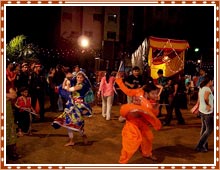 Gujarat
is known as the 'Land of Festivals'. A number of fairs and festivals are
celebrated in the state with great fervor and joy. The celebrations of
these occasions are accompanied with traditional dance and music
performances. The state has been blessed with a rich tradition of
performing arts. The various song, dance and drama forms practiced in
Gujarat are famous throughout India. The most fascinating fact of all is
that the origin of these performing arts dates back to the ancient era
of Lord Krishna. According to Hindu mythology, Lord Krishna spent the
early days of his life in Gokul.
Gujarat
is known as the 'Land of Festivals'. A number of fairs and festivals are
celebrated in the state with great fervor and joy. The celebrations of
these occasions are accompanied with traditional dance and music
performances. The state has been blessed with a rich tradition of
performing arts. The various song, dance and drama forms practiced in
Gujarat are famous throughout India. The most fascinating fact of all is
that the origin of these performing arts dates back to the ancient era
of Lord Krishna. According to Hindu mythology, Lord Krishna spent the
early days of his life in Gokul.Here, he charmed the natives by playing the flute and dancing. He performed Raas Leela with the Gopis, which is remembered till date. After he became the ruler of Dwarka, he patronized folk songs and dances in his kingdom. Since, then the Gujaratis have maintained the tradition and preserved the heritage in all its glory. The folk drama popular in Gujarat is known as Bhavai. Other popular folk dances of Gujarat are Tippani Nritya, Siddi Dance, Padhar Nritya, Dangi Nritya and local tribal dances.
Dandiya Raas
Dandiya Raas is the most popular dance of Gujarat. The dance is so popular that it is performed not only in the state, but throughout India. Infact, it is a special feature of the Navratri festival. The festival is celebrated to pay homage to the nine incarnations of Mata Amb, the Mother Goddess. People observe fasts on all nine days of the festival and pay regular visits to temples.
Garba Raas
Garba Raas is a popular folk dance of Gujarat. The dance is said to have an ancient origin. Like the credit for popularizing Ras Leela goes to Lord Krishna, the credit for promoting Garba goes to Usha, the grand daughter-in-law of Shri Krishna. It was earlier known as Lasya Nritya. Ras Garba is a typical dance performed by women in the honor of Ma Jagdambe, the Mother Goddess.
Ras Dance
Ras is one of the popular dance forms of Gujarat. It is derived from the Ras Leela performed by Lord Krishna in Gokul and Vrindavan. Ras is usually performed by a group of youthful people. They take measured steps and move in a circle, on the beats of musical instruments, like Dhol, Cymbals, Zanz and Shehnai (Flute). The dancers wear colorful folk costumes for the dance. Men wear a small coat called Kedia, teamed with a kurta having tight sleeves, pleated frills at the waist and embroidered borders. They also wear tight trousers, colorful turbans and kamarbandha (waist band).









